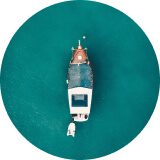Surfing in France
Surfing guide to France, Europe
France has 15 main surf areas. There are 103 surf spots and 16 surf holidays. Go explore!
Overview of surfing in France
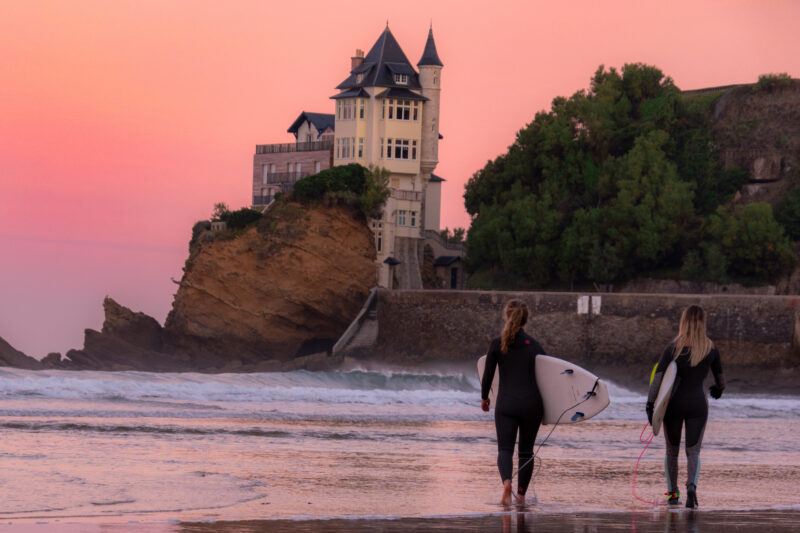
Although France is more often associated with wine, cheese, fashion, and châteaux than with barrels and surfboards, it has become one of the most iconic surf destinations north of the equator. France sits at the crossroads of European elegance and Atlantic power, giving travelling surfers a destination that fuses world-class culture with world-class waves, and offers a unique way of life found only in France. While Australia is renowned for its legendary surf regions, especially the Gold Coast with its world-famous breaks and vibrant surf culture, France stands proudly among the world’s top surf destinations.
The country isn’t cheap compared to neighbouring Portugal or Spain, but what you get in return is second to none: incredible cuisine, fine wine, history at every turn, chic beach towns, and a coastline that feels endless. The Atlantic sea shapes the surf conditions along these shores, with the Atlantic-facing shores of southwest France exposed to consistent North Atlantic swell, creating surf opportunities nearly year-round. Add to that a strong surf culture, easy infrastructure, and breathtaking scenery, plus the natural beauty and pristine nature of the French coastline, and you’ve got yourself one of the best surf trips you could possibly plan. To truly experience the culture and surf, you should visit France and immerse yourself in its vibrant scene.

More importantly for most surfers, France’s beaches and reefs pick up almost anything the Atlantic throws at them. The long sandy stretches of Landes, the reefs of the Basque coast, and the rugged bays of Brittany provide an incredible variety of setups: grinding beach breaks, mellow points, wedging slabs, and beginner-friendly rollers. If Portugal is the surfer’s warm and affordable playground, France is the polished older cousin with heavier surf, a bit more price tag, but just as much stoke.
Surfing in France is no longer niche—it’s mainstream. Events like the Quiksilver Pro France have turned Hossegor into a household name, and images of La Gravière’s sand-churning tubes have lured surfers from across the globe. France is home to some of the world’s most iconic surf competitions and is recognised as one of the world’s premier surf destinations. Towns like Biarritz and Anglet buzz with surf schools, board shops, and cafes full of sandy-haired groms. The French surf scene is vibrant, stylish, and proud of its Atlantic heritage.
Surf Regions in France

This guide will focus mainly on mainland France’s Atlantic coastline, though France also boasts island territories with world-class surf (like Réunion or Tahiti). But if you’re planning your Euro surf trip, you’re probably eyeing Hossegor, Biarritz, and beyond—so let’s paddle straight into it.
Hossegor

Hossegor is the surf capital of France. Known as the “European Pipeline,” La Gravière has made a name for itself as one of the heaviest, hollowest beach breaks in the world. Every autumn, the world’s best pros flock here for the WSL Quiksilver Pro, and the whole town turns into a week-long surf festival. This international competition draws huge crowds of spectators, all eager to watch the action up close.
The town itself is small but stylish, filled with surf shops, bars, and cafes. The beach runs for miles, with shifting sand bars constantly influencing where the waves are breaking and creating Hossegor’s famous surf conditions, meaning you can find uncrowded peaks just a short walk from the main action. But be warned: when it’s big, Hossegor is not for the faint of heart. It takes real skill and timing to grab the perfect wave here, and the thrill of catching one is unmatched. If you go left on a big day, you can easily leave yourself in the impact zone, so positioning and experience are crucial, especially with the dangers of heavy left-hand breaks. Expect beatings, snapped leashes, and broken boards. For intermediates or beginners, nearby Capbreton and Seignosse have slightly mellower options.
Biarritz
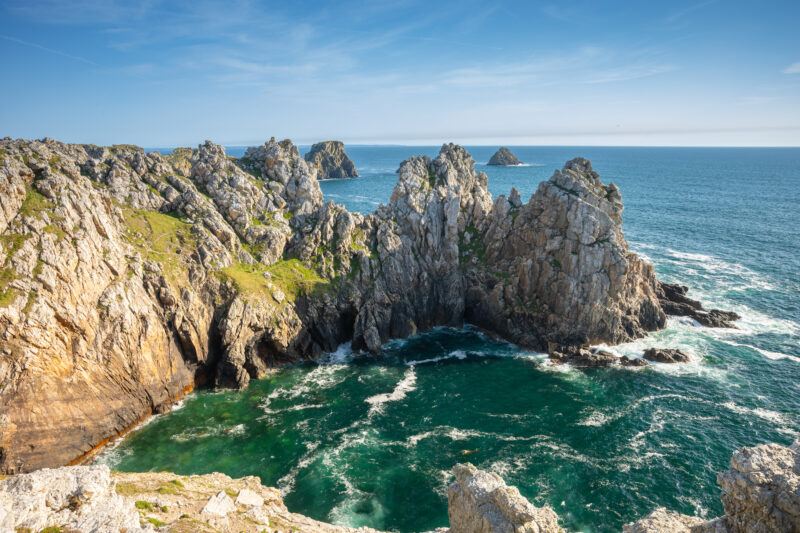
Often called the birthplace of European surfing, Biarritz has been attracting wave riders since the 1950s. The iconic Côte des Basques beach is perfect for beginners, longboarders, and anyone looking for a cruisy time. The vibe here is different from Hossegor—more elegant, more family-friendly, but still deeply surf-oriented.
Biarritz blends French Riviera glamour with surf culture. You’ll find beautiful architecture, fashionable boutiques, and plenty of surf schools ready to take beginners out on their first waves. It’s a great spot if you want a blend of surfing and cultural tourism.
Anglet
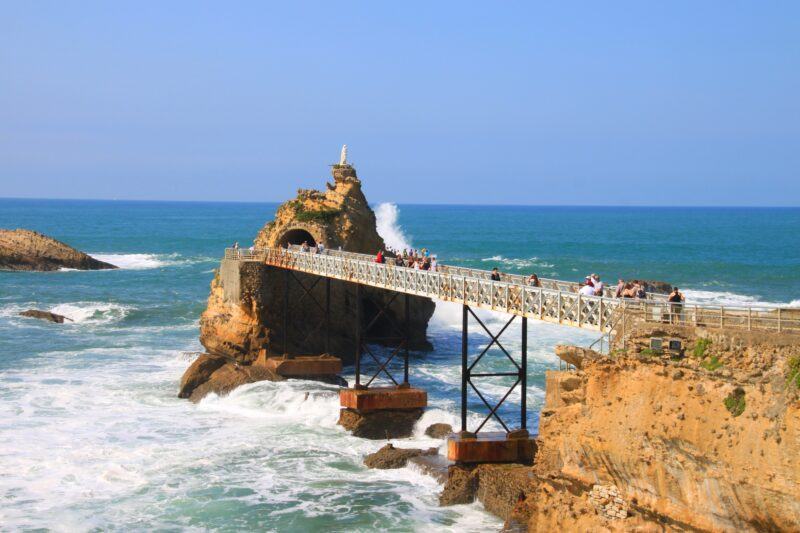
Wedged between Biarritz and Bayonne, Anglet has 11 beaches stretching along its coast. Known as “Little California,” it’s a hotbed of surf culture with constant swells and varied sandbanks. Les Cavaliers is the standout break: a punchy, powerful peak with a strong local scene. Jetties on the southern side of Les Cavaliers provide wind protection, which influences the surf conditions and helps prevent closeouts during larger swells. Anglet’s beaches can handle crowds, so even on busy summer days, you’ll usually find room to paddle out.
Lacanau
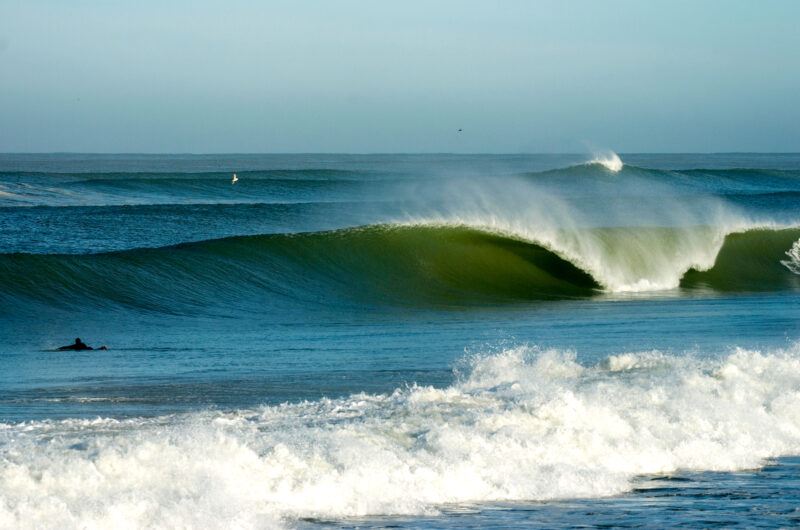
Further north, close to Bordeaux, Lacanau is another classic surf destination. It has a long history of hosting surf competitions and remains a consistent, versatile spot. The beach breaks here range from mellow summer peelers to storm-driven winter grinders. Lacanau is a favorite for family surf trips and holidaymakers, with surf camps, rentals, and plenty of nightlife.
Brittany (Bretagne)
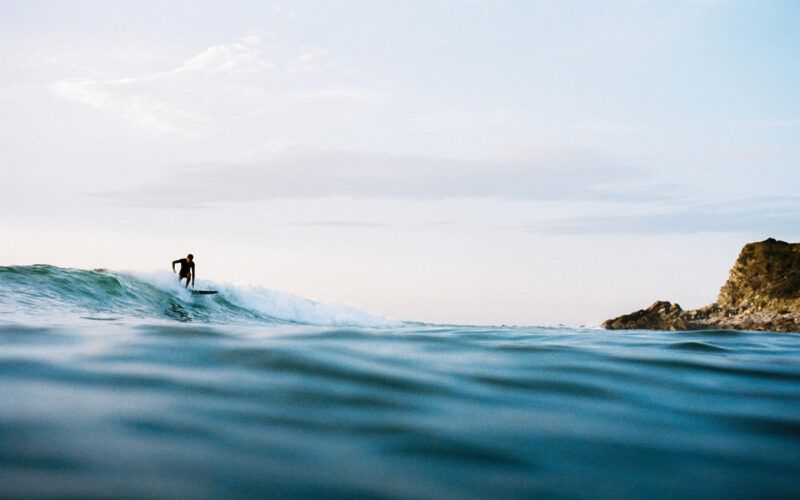
For a wilder, less-crowded surf experience, head north to Brittany. The rugged coastline is dotted with reefs, coves, and beaches that come alive when the swell is right. It’s less consistent than the Landes region, but when it’s on, it offers powerful waves and stunning backdrops of cliffs and ancient villages. La Torche is the most famous spot, attracting a mix of pros and weekend warriors.
Vendée
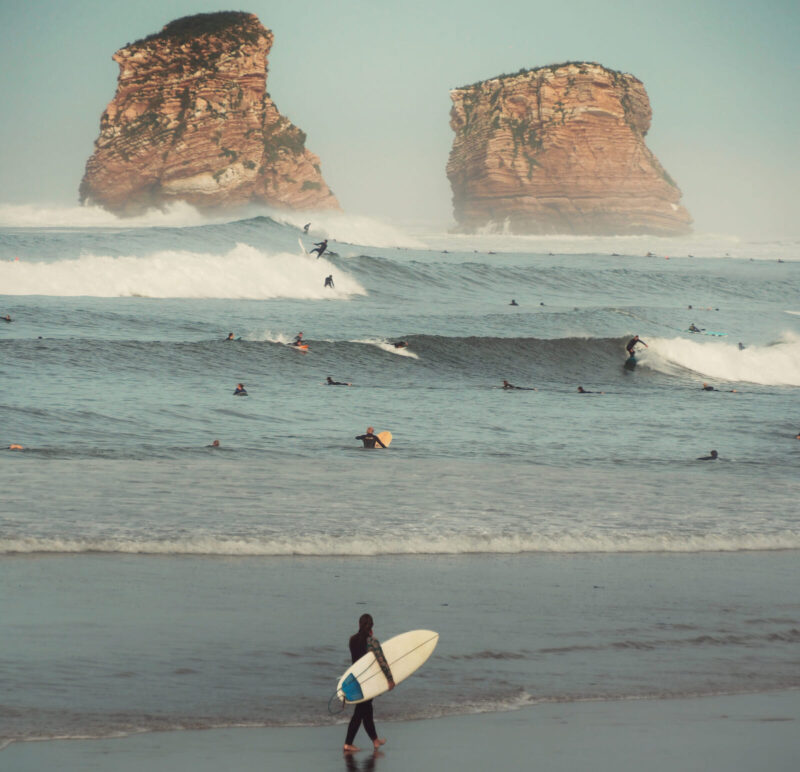
South of Brittany, the Vendée region offers long, sandy beaches that are perfect for intermediates and longboarders. It doesn’t get the same hype as Hossegor or Biarritz, but that’s part of the charm—you’ll often score uncrowded peaks. Popular spots include Sauveterre and Les Conches.
Basque Country (Guéthary & Beyond)
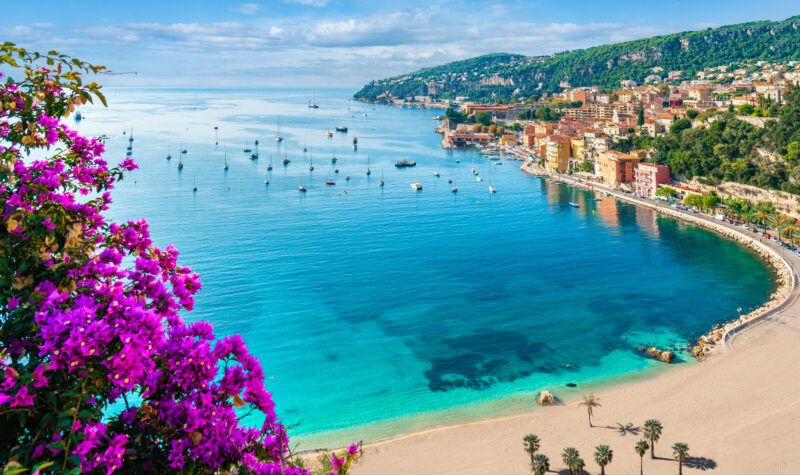
Just south of Biarritz, the Basque coast offers reefier setups, most famously Guéthary, where the reef creates powerful waves that break in deeper water. This long right-hand point is France’s big-wave spot, handling swells that would close out beach breaks elsewhere, making it suitable for experienced surfers and also offering both rights and lefts under certain conditions. The scene here is older, more traditional, and full of stylish longboarders.
The Good
- Consistent Atlantic swell all year.
- Some of Europe’s best waves (Hossegor, La Gravière, Guéthary), with an abundance of great waves for surfers of all levels.
- Strong surf culture and infrastructure—shops, schools, camps everywhere.
- France’s legendary food, wine, and après-surf café culture.
- Scenic towns and stylish coastal living.
The Bad
- Crowds, especially in Hossegor and Biarritz.
- Higher costs than Portugal or Spain.
- Heavy localism at marquee spots like La Gravière or Les Cavaliers.
- Winter storms can turn surf missions into a washout.

Getting there
Access
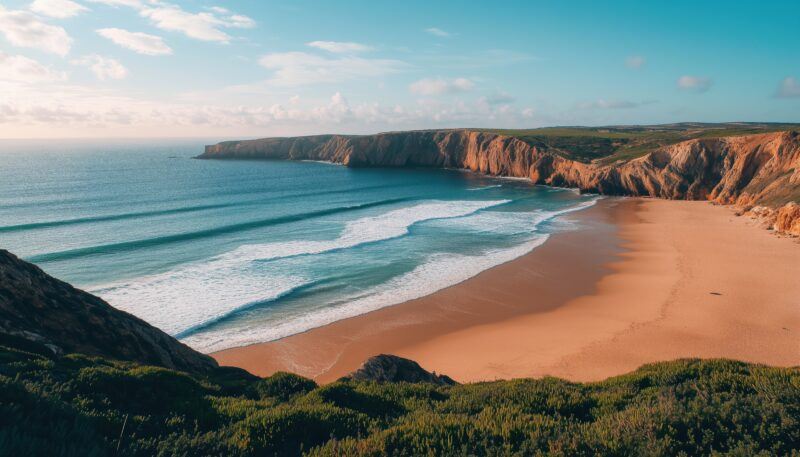
Getting to France is easy. Major airports in Biarritz, Bordeaux, and Paris connect directly to surf zones. High-speed trains (the TGV) make travel between regions fast and comfortable. Renting a car is the best option for surf trips, giving you freedom to chase swells up and down the coast. Roads are excellent, though tolls can add up quickly, and fuel is pricey.
For Hossegor, fly into Biarritz or Bordeaux. For Brittany, flights to Brest or Nantes work well. Public transport in cities is fine, but a rental car is essential for exploring surf spots. No need for 4x4s—the French coast is paved and well-connected.
Crowds
Hossegor and Biarritz in summer? Packed. Expect lineups full of locals, tourists, and surf schools, as well as a large number of visitors who flock to the beaches during the peak season. But France’s coastline is long, and with a bit of driving, you’ll find plenty of peaks to yourself. Fall is the best season for quality waves and manageable crowds. Winter clears out the tourists but leaves only the hardcore locals.
Lineup Lowdown
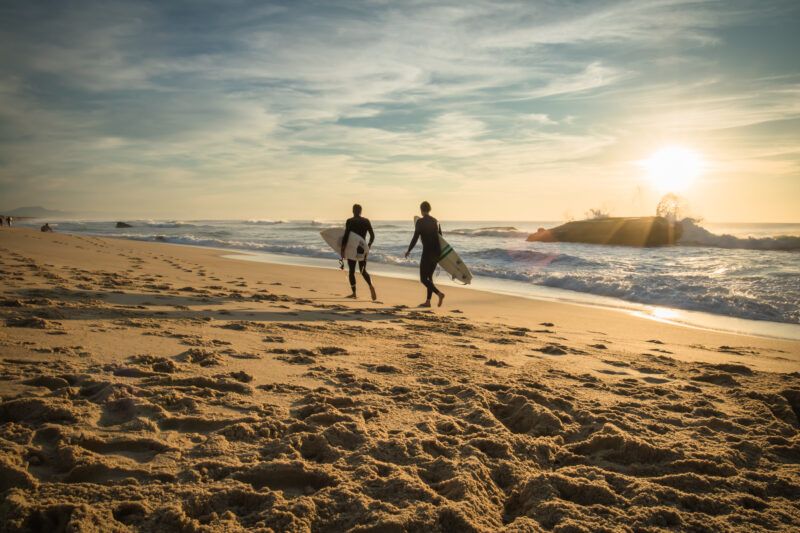
French surfers are passionate and protective, especially at flagship spots like Hossegor and Les Cavaliers. Respect the rules: don’t paddle straight to the peak, don’t snake waves, and always respect priority. Watch the lineup and observe how locals interact before paddling out. That said, outside the hot zones, lineups are generally friendly. In smaller towns and less-famous beaches, you’ll often get welcomed with smiles if you show good etiquette.
Surf spot overview


Surf seasons and when to go
The best time of the year to surf in France
Surf Seasons & when to go
- Fall (Sept–Nov): The prime season. Winter swells begin to arrive in September, bringing optimal surf conditions with the best sandbanks, offshore winds, consistent swells, warm(ish) water, and contests.
- Winter (Dec–Feb): Big swells, cold water, and stormy weather. For advanced surfers only.
- Spring (Mar–May): Shoulder season with lighter crowds, fun waves, and milder weather.
- Summer (Jun–Aug): Small waves, crowded beaches, perfect for beginners.
Water Temperatures
- Winter: 12–14°C → 4/3 or 5/4 wetsuit with booties.
- Summer: 18–22°C → 3/2 full suit or springsuit.
- Fall/Spring: 15–18°C → 3/2 or 4/3.
Weather
- Summer: Warm, sunny, beach weather (25–30°C).
- Fall: Mild, crisp mornings with warm afternoons.
- Winter: Cold, rainy, windy (8–15°C). Layers essential.
- Spring: Mixed, but increasingly pleasant.
Can’t-Miss Surf Spots
Hossegor – La Gravière
Europe’s Pipeline, rivaling other world-class surf spots like Bells Beach. Thick, hollow barrels that break boards and egos. When a wave is caught at La Gravière, surfers experience intense drag as the powerful barrels generate significant resistance, making each ride both challenging and exhilarating. Best in autumn, when offshore winds groom the sandbanks. Rip currents are common at Hossegor, so surfers should always be aware of their presence for safety.
Biarritz – Côte des Basques
Historic surf beach. Gentle, forgiving waves perfect for beginners, longboarders, and cruisers, especially suitable for those learning to surf.
Guéthary
A reefy right-hander that holds serious size, featuring challenging waves that attract advanced surfers. Known for its long walls and old-school surf culture.
Anglet – Les Cavaliers
Punchy, hollow beach break with a tight local crew. A proving ground for young French rippers.
La Torche (Brittany)
Exposed, consistent, and scenic. One of the few surf hubs in northern France, great for intermediates.
Lacanau
Consistent, versatile beach breaks with a lively surf town atmosphere.
France surf travel guide
Find trips that fit a flexible lifestyle
Learning to Surf in France

France’s Atlantic coastline is a dream come true for anyone looking to learn how to surf. With its long stretches of sandy beach and a steady supply of waves, it’s no wonder that beginners from around the world flock here to catch their first rides. The beach breaks around Hossegor are especially famous, offering some of the best surf spots for learning thanks to their forgiving sand bars and consistent surf. Local surf schools, like the renowned Hossegor Surf School, provide expert lessons that guide beginners through the basics—how to paddle, pop up, and read the waves—while also teaching essential ocean safety.
But it’s not just for newcomers. Experienced surfers are drawn to France for its challenging waves, especially when the winter swells roll in and transform the coast into a playground of powerful surf. The variety of breaks means you can progress at your own pace, moving from gentle rollers to more advanced peaks as your confidence grows. The region’s vibrant surf culture, friendly instructors, and stunning coastline make every lesson feel like a true adventure. Whether you’re catching your first wave or chasing bigger winter sets, France is a location where every surfer can find their place in the lineup.
Safety and Etiquette in the French Lineup
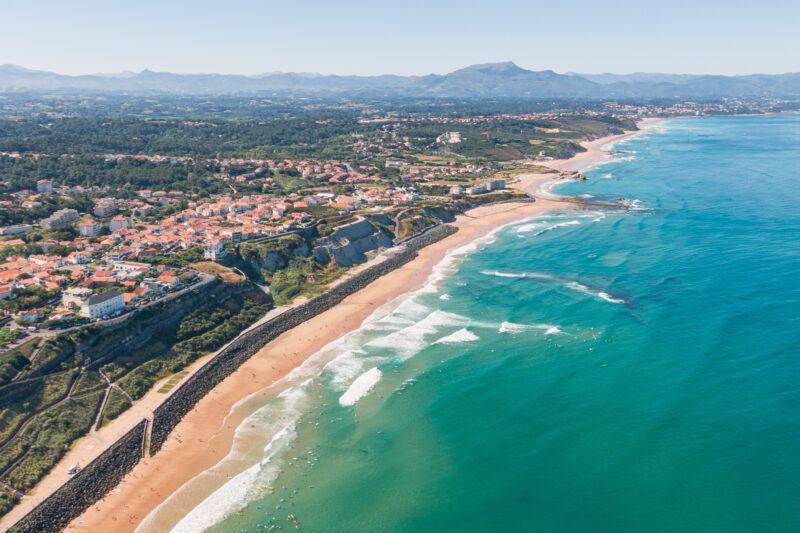
Surfing in France is as much about respect as it is about riding the best waves. For beginners, safety should always come first—surf with a buddy, stay within your limits, and avoid venturing out to challenging reef breaks or heavy winter surf until you’ve built up your skills. The Atlantic can be unpredictable, with strong rip currents and shifting sand bars, especially during the colder months, so always check local conditions and listen to lifeguard advice.
For experienced surfers, understanding lineup etiquette is crucial. The French surf community values respect: wait your turn, don’t drop in on others, and be mindful of the locals who know these breaks inside out. At world-class spots with powerful reef breaks, like Guéthary, the waves demand both skill and humility. By following these unwritten rules and looking out for one another, surfers help maintain the welcoming, vibrant culture that makes France such a special place to surf. Whether you’re paddling out for the first time or chasing the best waves of winter, a little courtesy goes a long way in the French lineup.
Surf and Yoga Retreats

For those seeking more than just great waves, France’s surf and yoga retreats offer the perfect blend of adventure and relaxation. These retreats are designed for surfers of all levels, from beginners eager to catch their first wave to experienced surfers looking to deepen their connection with the ocean and themselves. Set in stunning coastal locations like Hossegor and Biarritz, retreats typically include daily surf lessons, yoga sessions to improve flexibility and balance, and guided meditation to help you unwind after a day in the water.
Participants enjoy healthy meals, comfortable accommodation, and the chance to connect with like-minded surfers from around the world. The focus on nature and well-being means you’ll leave feeling refreshed, both physically and mentally. Whether you’re looking to improve your surfing technique, embrace a healthier lifestyle, or simply escape the stresses of daily life, a surf and yoga retreat in France is a unique way to experience the best of surf culture and coastal living.
Accommodation Options for Surfers
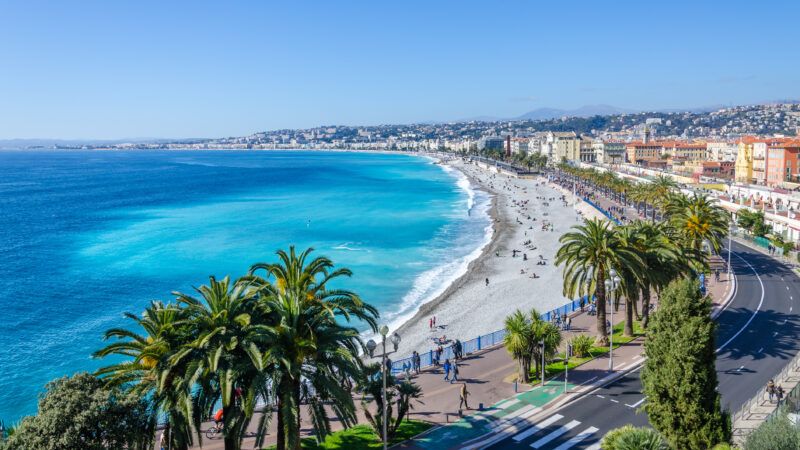
Finding the right place to stay is key to making the most of your surf trip in France. The country’s surf towns offer a wide range of accommodation options to suit every budget and style. From lively hostels and laid-back campsites to boutique hotels and private villas, there’s something for every surfer. Many surf schools and camps provide on-site lodging, making it easy to roll out of bed and head straight to the beach for your morning session.
In hotspots like Hossegor, you’ll find surf lodges and apartments just steps from the sand, while Biarritz and Lacanau offer everything from surf hotels to cozy guesthouses. Many of these places cater specifically to surfers, with amenities like board storage, wetsuit hire, and even surf lessons included in your stay. Whether you’re traveling solo, with friends, or as a family, you’ll find the perfect base to enjoy the waves and the vibrant surf scene that makes France such a memorable destination.
Comparison to Other Surf Destinations

When it comes to world-class surf trips, France holds its own against legendary destinations like Australia’s Gold Coast, California’s iconic coastline, and Spain’s northern breaks. What sets France apart is its unique blend of consistent waves, welcoming surf culture, and a laid-back yet stylish atmosphere. The beach breaks around Hossegor are renowned for delivering some of the best waves in the world, suitable for everyone from beginners to experienced surfers chasing the thrill of winter swells.
Unlike the bustling competition vibe of the Gold Coast or the crowded lineups of California, France offers a more relaxed and community-focused experience. The coastline is dotted with charming towns, delicious food, and a rich surf history that draws surfers back year after year. Whether you’re a professional surfer looking for challenging waves or a beginner eager to learn in a supportive environment, France’s surf culture, diverse breaks, and beautiful scenery make it a top choice for your next surf trip. With so much to offer both in and out of the water, France truly stands out as one of the world’s most rewarding surf destinations.
Expenses

- Accommodation: Hostels €25–30, Airbnbs from €60, hotels can climb into the hundreds.
- Food: €15–20 for a solid meal with wine at a local bistro. Splurge dinners €50+.
- Transport: Rental cars €45–60/day. Tolls and gas are expensive.
- Surf Costs: Board rentals ~€20/day, surf lessons €35–45/session.
France isn’t the cheapest surf destination, but you can budget smart with camping, cooking, and traveling outside peak summer season.
Cultural Notes
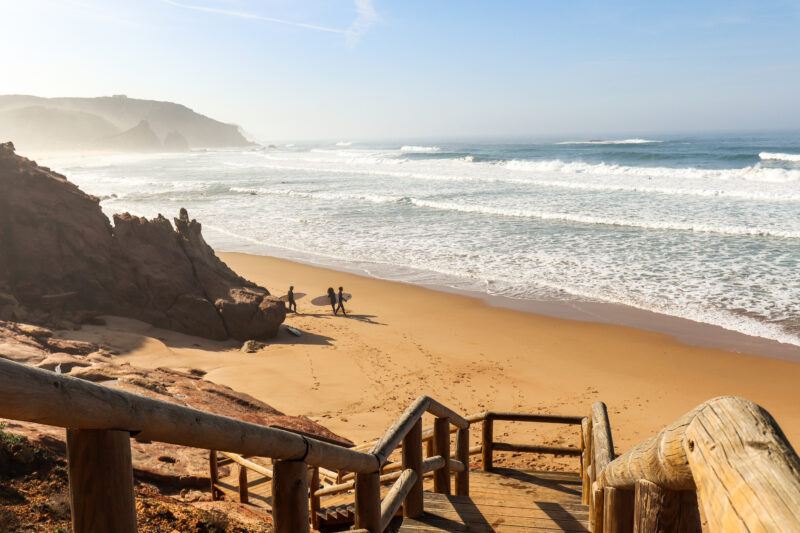
French surf culture is stylish and proud. Locals love their beaches, their cuisine, and their lifestyle. A few cultural pointers:
- Try a few French phrases (“Bonjour,” “Merci,” “S’il vous plaît”). Locals appreciate the effort.
- Dress well—even in surf towns, style matters.
- Respect lineup etiquette—it’s not Bali free-for-all vibes.
- Café culture is huge: post-surf espressos are part of the ritual.
In addition to surfing, visitors can also snowboard in the Pyrenees, highlighting the diversity of outdoor activities available in France.
Cell Coverage & Wi-Fi
Coverage is excellent, especially along the southwest. SIM cards are cheap, Wi-Fi is everywhere in cafes, hotels, and restaurants. No stress staying connected.
Final Thoughts
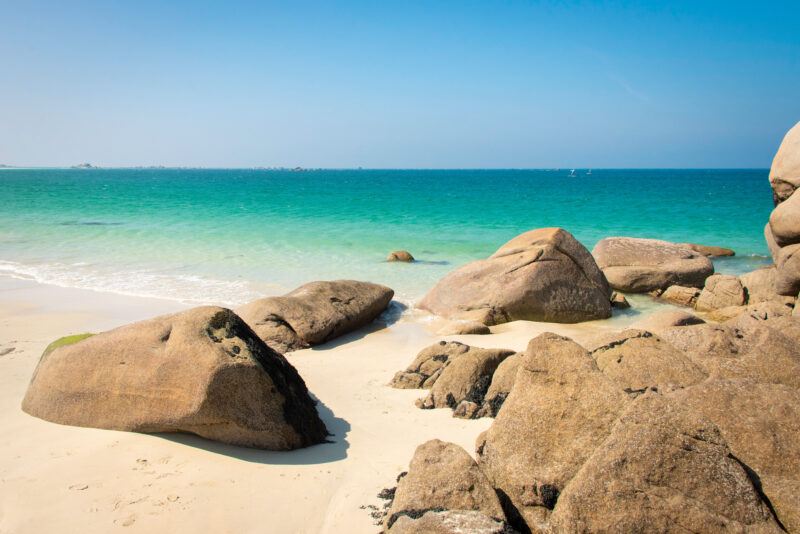
France is a surf destination that blends heavy waves with high culture. Hossegor will challenge even advanced surfers with its thumping barrels, while Biarritz welcomes first-timers with open arms. Every surfer, from beginners to experts, can find their place along the French coast. Add in wine, cheese, stylish beach towns, and scenic drives, and you’ve got a surf trip that feels like a cultural adventure as much as a wave hunt.
From wild Brittany to glamorous Biarritz, France offers waves for every level, all wrapped in that unmistakable French lifestyle. Pack your wetsuit, learn to say “bonjour,” and get ready to surf some of the best waves in Europe.





